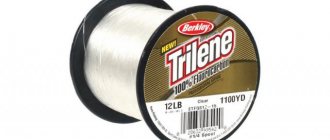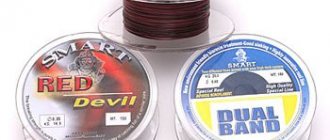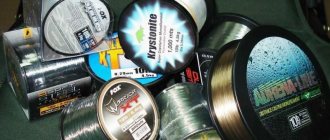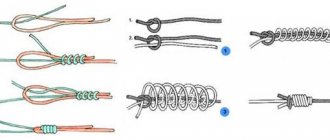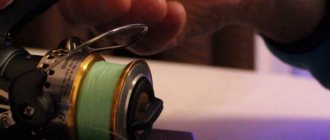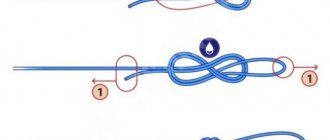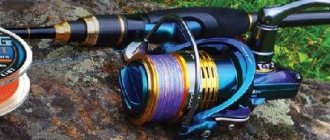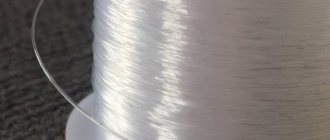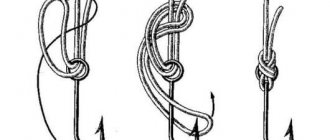Fishing lines are artificial, thin, usually transparent fishing threads.
For fishing, fishing line is one of the main components of the fishing rod, with the help of which the fishing itself is carried out. The first signal that comes to the fisher about the caught prey is sent to the fishing line, after which it is transmitted to the fishing rod.
Without a fishing line, there is no physical connection between the fisherman and the fish. Having caught a large fish, the angler will begin to wonder whether this fishing line will withstand the load?
It all depends on the fisherman himself. If you use a new fishing line, the angler has a better chance of catching what he wants, since modern fishing lines are stronger and of better quality.
The importance of line selection
In the old days, anglers did not have the opportunity to choose good quality fishing lines that were inconspicuous, thin, and with good characteristics. Previously, fishing line was made from simple horsehair.
Subsequently, fishing lines began to be made from materials such as linen, silk. Over time, fishing lines began to be made from homogeneous or braided nylon fibers. What kinds of fishing lines are there now?
A good fishing line should have the following characteristics: strength, thinness, inconspicuousness in water, and not susceptible to rotting.
Division of fishing lines by class: monofilament and braid. Both in the first type and in the second, there is a specialized fishing line available. For example: Winter-type monofilaments are divided into monofilament, polymer and high-polymer. Monofilaments are also divided into types, namely: nylon, nylon. When producing fishing lines, the manufacturer tries to achieve a positive result in all characteristics; for this, the fisherman needs to think in advance what results he expects from this fishing line.
Sizes of fishing lines
| Lb | Diameter (inches) | Diameter (mm) | ||||
| pounds | min | Max | average | min | Max | average |
| 2 | 0,004 | 0,006 | 0,006 | 0,10 | 0,15 | 0,15 |
| 4 | 0,006 | 0,009 | 0,008 | 0,15 | 0,23 | 0,20 |
| 6 | 0,008 | 0,010 | 0,010 | 0,20 | 0,25 | 0,25 |
| 8 | 0,009 | 0.012 | 0,011 | 0,23 | 0,30 | 0,28 |
| 10 | 0,011 | 0.012 | 0.012 | 0,28 | 0,30 | 0,30 |
| 12 | 0.012 | 0,014 | 0,013 | 0,30 | 0,36 | 0,33 |
| 14 | 0,014 | 0,015 | 0,014 | 0,36 | 0,38 | 0,36 |
| 20 | 0,016 | 0,018 | 0,018 | 0,41 | 0,46 | 0,46 |
| 30 | 0,018 | 0,022 | 0,022 | 0,46 | 0,56 | 0,56 |
| 40 | 0,022 | 0,026 | 0,024 | 0,56 | 0,66 | 0,61 |
| 50 | 0,026 | 0,030 | 0,028 | 0,66 | 0,76 | 0,71 |
| 80 | 0,029 | 0,039 | 0,035 | 0,74 | 0,99 | 0,89 |
| 130 | 0,038 | 0,047 | 0,044 | 0,97 | 1,19 | 1,12 |
We recommend: Minimum fish sizes allowed for catching for the Far Eastern fishery basin, save to bookmarks
Data taken from the Stren fishing line website, other manufacturers have similar sizes.
The fishing line does not have an exact diameter, and differs from batch to batch, so its diameter always fluctuates within the range set by the manufacturer. Therefore, the size indicated on the package is average, not exact.
Lb is the tension force, this parameter is used to indicate the tension of the bow string, shows the breaking load of the fishing line, measured in pounds. One pound is equal to 0.4536 kg.
Strength of fishing line and fishing line in general
Line, a thin synthetic thread wound on the spool of a reel, connects all parts of the fishing rod together and bears the main load when hooking and landing fish. Therefore, it must be equally strong along its entire length, not get wet in water, not rot, and with the smallest thickness be able to withstand the greatest load (have a high tensile strength).
Synthetic fishing lines, which have become widespread, are durable, elastic and do not rot. They are used for all types of amateur gear. They can be twisted, woven from the finest fibers and in one thread - the so-called monofilament. If you choose a fishing line with a thick diameter (0.3-0.6 mm or more), then you will have at your disposal a powerful tool for pulling out bottom vegetation and snags, as well as all sorts of other nonsense.
Such fishing line is usually very inelastic, which very often leads to the formation of a “beard” (excessive line coming off the reel and clogging the rings and reel elements with it) even if you use a spinning reel.
In addition, a thick fishing line has a strong windage , so in a strong wind it is easily blown far to the side, and along with it the bait. The consequences are obvious...
If you choose a thin line (0.10-0.15 mm or less), then the elasticity of the line will allow you to gracefully cast the bait with a low probability of beard formation and low windage. But even a more or less large perch, when enraged, will easily tear it, and you will lose the trophy.
For a thin fishing line there is one “but” : if you take a braided fishing line (which costs much more than a regular one), then the diameter of the fishing line can be reduced to a minimum. So, with a braided line with a diameter of 0.12-0.14 mm, you can fight very large prey without worrying about the possibility of the line breaking at the most inopportune moment. Braided fishing line ideally meets the conditions of elasticity and strength (in fact, this is indicated by its price).
By default, most manufacturers indicate the so-called “linear breaking load,” meaning by this arbitrary term the weight at which a dry line without knots breaks. For practical fishing, this figure means nothing: it is impossible to fish on land without tying a hook.
Sometimes the label states that the data applies to wet line and a specific knot. However, a lot depends on whether the angler ties this knot correctly and how carefully he does it. It is quite possible that he prefers a completely different node. In addition, during use, the fishing line constantly loses strength.
The quality of the fishing line is primarily characterized by its strength:
ratio of weight in kilograms to diameter in millimeters
During operation, the fishing line is subjected to certain loads. It is affected by a number of factors that change its performance characteristics, initially specified by the manufacturer.
During casting, the line is subject to friction against the side of the reel spool and the rod ring. Friction increases when reeling in the fishing line - the resistance of the bait in the water affects it - but to a much greater extent when retrieving hooked fish. In the process of fighting fish, increased friction of the fishing line against the line roller occurs.
Therefore, the quality of the inner surface of the rings and line roller is of significant importance - low quality, and even more so, scratches and chips contribute to rapid wear of the fishing line and weakening of its strength. In addition, during the fishing process, the fishing line is subjected to additional mechanical stress upon contact with microscopic particles in the water, sand, silt, stones and snags.
All kinds of knots weaken the fishing line: practice has proven that even the most “masterful” knot weakens the fishing line by at least 10% of the nominal strength, and a knot that retains 100% strength simply does not exist.
Twisting of the line when using rotating spinners - Devons - has a negative effect on strength. The use of snap hooks and eccentric weights (with a shifted center of gravity) reduces, but does not eliminate, line twisting.
The fishing line also deteriorates in cases where the spinning angler, during a fight with a hooked fish, winds the fishing line directly onto the reel, without using the “pumping out” technique (pulling up a resisting fish with a rod and then reeling in the weakened fishing line).
A heavily twisted line forms loops that make casting difficult, compromise the strength of the line and lead to wasted time untangling the beard.
The strength of a fishing line is indicated as the cross-section of the fishing line in millimeters per breaking force in kilograms. The parameters printed on the manufacturer's labels do not always correspond to reality. It is not uncommon to find a fishing line with excellent characteristics on the label, but when checked, it turns out that the 0.25 mm fishing line is 0.255 mm or 0.26 mm thick.
If a fishing line of a certain section, when measured, shows a significant discrepancy in the indicators in individual sections along the entire length, then this indicates its low quality. Such gear can present an unpleasant surprise to the fisherman at the most inopportune moment.
The strength of the fishing line is expressed in kilograms.
The measurement is carried out in a dry state, at a laboratory humidity of 50%. The strength of a wet fishing line (under natural conditions) drops by up to 30%, depending on its quality.
During intensive fishing and the inevitable snags, the wet fishing line is subject to forces that change the structure and cross-section of the fishing line and lead to irreversible deformations. For example, a line with a cross-section of 0.25 mm, used all season, had (in the first few meters) a cross-section close to 0.23 mm, and in some areas even 0.21 mm.
When wet, a fishing line wound on a spool also undergoes deformation, which critically reduces the strength of the fishing line. There are known cases when the fishing line, drying out, compressed the plastic spool with such force that the latter burst.
In addition to the above factors, the quality (survivability) of the fishing line is also affected by a number of chemical processes; exposure to sunlight, active chemicals dissolved in water as a result of pollution of water bodies, shorten the life of the fishing line.
At the beginning of the season, it is necessary to check the condition of the fishing line. Symptoms of line disease include loss of surface smoothness, dullness, or discoloration. In some cases, you can cut off several meters of damaged fishing line. Rewind the fishing line onto the spool from the other end so that the used section is under the main mass of the fishing line, or wind the old one as a lining for the new fishing line.
Before using the fishing line, it is advisable to straighten it. For this purpose, the fishing line is unwound to its full length, choosing a suitable section of the coast or meadow, where it is possible to walk some distance with the unraveled fishing line. After that, the fishing line should be wound onto the spool with light force, after passing it through a piece of clean rag. Thus, the surface of the fishing line is cleared of dust and dried algae particles.
Another method of straightening is the method of letting the entire line from the reel follow the flow of water. Standing on a protruding river bank or being in a boat, you need to lower the entire line, while clearing it, as in the first case.
Some fishing companies produce a special double-effect shampoo that cleans the fishing line and at the same time coats its surface with a preservative compound. After processing, the fishing line looks like new.
- For those fishermen who actively fish with spinning rods throughout the season, it is better to replace the fishing line with a new one, and use the used one to catch small fish in more favorable conditions.
Anglers often claim that knots greatly reduce the strength of the fishing line. This is only partly true. With a correctly selected and carefully tied knot, you can completely rely on the linear strength of the fishing line.
There are many knots that can reduce the wear rate of the fishing line at the knot site. However, it should be borne in mind that even high-strength fishing line usually wears out relatively quickly and changes its properties under the influence of the sun and water, so experienced fishermen change thin fishing line annually. Some foreign companies produce fishing line with a strength slightly less than the upper limit indicated in the table, but with increased elasticity and durability.
The color of the fishing line, as practice shows, is not particularly important. Modern fishing line comes in a wide variety of shades and is used equally successfully regardless of its color. It is not recommended to dye fishing line at home - this can only lead to a deterioration in its quality. If an angler wants to succeed, he must use the thinnest and strongest line, regardless of its color.
ABOUT LESKA
The fishing line is the link between the angler and the fish. The accuracy of casting, the action of the bait, and the successful landing of fish depend on its correct choice.
In Dorling Kindersley's "Fishing Encyclopedia" (1994), all such fishing lines were called in one word - monofilament, but just 2 years later in the no less respectable publication "The Fishing Sourcebook" two types are already mentioned: monofilament and copolymer ( copolymer) fishing line. At the moment, a class of high-copolymer lines has been added to them.
These three types differ in chemical composition and production method. This is the classification used by manufacturers:
Learning to choose monofilament fishing line
Andrey Yanshevsky Fishing line, as you know, is divided into two large classes - monofilament and braided. Monofilament fishing line is a fishing line that consists of a single thread. The thread has a diameter. There is a common colloquial definition of the thickness of a fishing line as a cross-section - this is absolutely wrong, since the cross-section is the area, and the thickness of the thread is determined solely by the diameter.
In addition to the diameter, which can be very different, for example, monofilaments with a diameter of 0.029 mm are known, any fishing line is characterized by such parameters as length, calibration, rigidity, resistance to abrasion, ultraviolet radiation, sea water and sand-filled water; strength at the knot, density, which determines whether this fishing line sinks or floats.
There is one more consumer, and very important, characteristic of fishing line, which fishermen define as “fresh” or “old”. It’s important because “fresh” fishing line is strong, and “old” fishing line is just that: old. Determining the age of a fishing line is quite simple. If the surface of the thread is matte, this means that the fishing line has aged, that is, microcracks have formed on its surface under the influence of heat, ultraviolet radiation or mechanical stress. The aging of fishing line occurs because stabilizers and plasticizers sweat out of it over time or under the influence of temperature. The “aging” time depends both on the original quality of the fishing line and on storage conditions. It is best to store any monofilament in the refrigerator, that is, at a low temperature. Line calibration Line calibration means that a given monofilament is uniform in diameter along its entire length. It's very easy to check. To do this, you need to clamp a small sinker on the fishing line. By moving the sinker, you will immediately find those places on the fishing line where it is thicker; this is where the sinker will get stuck. This line is not suitable for fishing.
Poorly calibrated fishing line can only be used if you have deliberately chosen monofilament with a large margin of safety. If the fishing line is well calibrated, it is advisable to check its breaking strength. Checking the strength of the fishing line At home, the strength of the fishing line can be checked on a piece of wet fishing line about a meter long using a dynamometer. It is convenient to use flat electronic scales as a dynamometer. To do this, place the fishing line on the scales and with both hands, evenly, but not quickly, pull the ends of the fishing line down until it breaks. During a break, the scale will show the strength of the fishing line. This method is very approximate and is only suitable for relative comparison of different fishing lines with the same diameter. Line diameter First of all, check the line diameter using a micrometer, but you need to keep in mind that fishing lines thicker than 0.1 mm can be accurately measured in this way. To measure the diameter of thinner lines, only optical methods are used. Line stiffness
A very important characteristic. Rigid fishing line is usually more durable due to a higher degree of axial orientation of the surface layers. What does it mean? The process of making a fishing line consists of drawing a thread from a melted polymer and pulling it through a calibrated hole - a spinneret.
In the process of pulling the thread through the spinneret, a fishing line of the required diameter is formed, and from the point of view of polymer physics, the polymer macromolecules are straightened and aligned or oriented along the axis of the thread. Orientation occurs more completely in the surface layer of the thread than inside the fiber - this is the axial orientation of the surface layer.
The higher the degree of molecular orientation, the more fully the strength characteristics of the raw materials are realized in the final line, but the stiffer the line is. It is precisely because of its high rigidity that monofilament usually loses strength at the knot. Rigid fishing lines have “memory”. Here it is necessary to note the fact that both the concept of rigidity itself and the concept of memory have a comparative definition.
The disadvantages of rigid lines, of course, include their difficulty in coming off the spool of a spinning reel, which leads to a decrease in casting range. But too soft a fishing line easily gets tangled, twists and has increased residual deformation after stretching, which also leads to a relatively rapid loss of strength due to stretching during operation. We look at the markings of the fishing line When choosing a fishing line in a store, we are guided by the markings that are applied to the packaging of the fishing line, and at the same time we are accustomed to the length in meters, diameter in millimeters and tensile strength in kilograms being indicated on the label of the fishing line. But in the USA and Japan, a slightly different label has been adopted, the essence of which is different from what we are used to.
Let's take as an example the marking of a Japanese fishing line, on which the line number is indicated instead of the diameter. For example, the number 0.03 is indicated on the monofilament line - what does this mean? In order to convert a Japanese number to millimeters, just refer to the conversion table, which is given on this page.
It should be noted that this numbering is used to mark not only monofilament, but also braided cords. The good thing for us is that on most labels, in addition to the number, the diameter of the fishing line is indicated in millimeters, and up to hundredths. Why such precision? Firstly, calibration accuracy indicates the high quality of the fishing line and its uniformity in length, and secondly, such accuracy is necessary for recording, for example, records or competition results. The fact is that, for example, in America, competitions for the largest specimen caught on a fishing line of a certain diameter are widespread. This is approximately like in boxing or weightlifting, where athletes are divided into weight categories measured by diameter. That is why the Japanese simply do not indicate the true breaking load on fishing lines for the domestic and American markets, and why? After all, everyone understands perfectly well that if a given fishing line is created for competitions, it means that it has the best characteristics, and also everyone understands that in addition to the strength of the fishing line, the skill of the fisherman, the balance of the entire tackle as a whole, and, what Let's be honest, luck. Line age
But the most interesting thing happens when you first look at the label and see the inscription that “fresh, “cool,” sporty and truly Japanese fishing line, for example with a diameter of 0.144 mm, supposedly has a strength of 1.5 kg. If you see such a marking, then know that the kilograms indicated on the label do not mean the strength of the fishing line, but, so to speak, its power.
This marking is purely American, since for Americans the main thing in fishing line is not the tensile strength, but the weight class. This weight class is indicated on the label in pounds, and in brackets (for Europeans, including you and me) in kilograms. And in conventional terms, either pounds or kilograms. Conditional, because in such markings a pound is equated to half a kilo or a kilogram to two pounds - it’s difficult to say exactly. But marking the fishing line by power in conventional pounds is very convenient; during the design of spinning rods for the American market, not only the optimal weight of the bait is marked, but also the fishing line recommended by power. And this recommended “power” of the fishing line indicates the power of the rod itself. Example Two spinning rods can be given as an example. Both spinning rods differ in length by six centimeters, but one has an optimal test for baits of 5-21g and a line of 6-10 pounds, and the other has a test for baits of 5-18g and a line of 6-12 pounds. And such markings directly indicate how the second spinning rod is more durable and reliable compared to the first. Again, when an angler chooses a spinning rod for himself, he thinks about what size fish he will catch, and markings on the rod according to the fishing line power make the choice very easy. What to look for when buying a fishing line Markings and label design help a lot when choosing a fishing line. Bad, ugly and unclear printing on the label, not attractive. A crooked and uncomfortable spool, uneven laying of the fishing line directly indicate that the fishing line is not of the highest quality. And the seller can rant as much as he wants and prove that the ugly fishing line is very strong, but the only question is. How long will it be durable or will it “fall apart” on the first fishing trip?
Despite the fact that many fishing lines have a variety of additional words on the labels, such as “Teflon coating”, “best in the world”, “extra strong and soft”, you should not pay much attention to them, since it is much easier and cheaper to write on the label advertising words, how to make a new generation fishing line.
In fact, only a few factories in the world make good fishing lines, and they cost approximately the same. Therefore, when choosing a fishing line for a float rod, all that remains is to choose a fishing line according to the price category. If you need fishing line, as they say, for one fishing trip for crucian carp, then it’s better to take a cheap fishing line and then calmly say goodbye to it. Also, if you fish in settling tanks or on a warm current below a state district power plant in alkaline water, then it is better to use the cheapest line possible. In an alkaline environment, the most elite fishing line can withstand no more than two fishing trips. But if you fish in ecologically clean waters, then you simply cannot do without the highest quality fishing line. A good fishing line will last up to four years, and cautious fish will not be afraid of ultra-thin tackle.
What is monofilament line made of?
The modern fishing market presents 4 types of material for making monofilament lines:
- monofilament or monofilament ;
- copolymer or copolymer ;
- high-polymer or high-copolymer ;
- fluorocarbon or fluorocarbon .
Their distinctive feature is the material and manufacturing method. Each type is not ideal; there are both pros and cons, which will be discussed below.
2.1 MonoFilament
This type of fishing line is made by extrusion from polyamide (traditional nylon), when soft and molten material is pushed through a special hole in the extruder (process equipment).
You can read more about the technical process of “extrusion” here https://ru.wikipedia.org/
Advantages of monofilament lines:
- fit well on the reel, making it easier to cast the bait;
- tolerate temperature changes well;
- have sufficient transparency;
- good stretch and strength;
- a certain resistance at the node;
- good shock absorption when fishing for prey, which relieves the load on the reel mechanisms.
Disadvantages of monofilament lines:
- dry out (age) due to natural influences;
- limited shelf life;
- low rigidity;
- high cost.
What to use with:
- with spinners (rotating);
- with low-density baits, for example, wobblers.
A short video about the production of this thread
2.2 Copolymer
The fishing line is made from several types of materials using special technologies aimed at improving the external properties of the thread in order to achieve strength and quality when catching various types of fish. Unlike the above type, this fishing line is more rigid.
Area of application : jig fishing with a spinning rod.
Advantages of copolymer lines:
- do not get confused, due to this property, hooking is easy;
- more rigid, the jerks (bites) of the fish are better felt;
- elastic enough to absorb the jerks of production;
- durable;
- wear-resistant.
Disadvantages of copolymer lines:
- high cost.
- less tensile strength than nylon fishing lines.
2.3 High-copolymer
When producing this type of fishing line, the manufacturer used even more complex technology and materials.
Advantages of high-polymer fishing lines:
- high strength;
- quality that allows you to use such a fishing line in different weather conditions and fishing;
- good “friendship” with water;
- fast-sinking;
- performs well when exposed to sunlight and frost;
Disadvantages of high-polymer fishing lines:
- high cost.
2.4 Fluorocarbon
The fishing line is made of polymer (polyvinylidene fluoride or PVDF).
Advantages of fluorocarbon:
- not visible in water.
- when in water, it does not absorb moisture, which allows it to retain its original characteristics (section, strength) for a long time;
- tolerates exposure to hot and cold temperatures (from – 40 degrees to + 160)
- Due to its hard top layer of material, it is resistant to abrasion.
Disadvantages of fluorocarbon fishing line:
- high cost;
- in comparison with other fishing lines, it has the lowest breaking load compared to other types of monofilament;
- excessively hard;
- not strong knots, since when it gets into water it does not swell and the knot is not strong because of this, so many people use glue to secure the knot, which causes additional trouble, and the installation of the knot must be done carefully so as not to tear the fishing line.
Application area:
- as a leash;
- less often as the main line for spinning fishing;
- Popular among pole fishermen.
Attention! On the fishing market there are fishing lines from manufacturers who, in order to reduce the cost of their goods, produce nylon fishing lines coated with fluorocarbon. The packaging says “fluorocarbon coated”.
You can read more about the properties of fluorocarbon fishing line on the page https://fishing.zp.ua/poplavochnaya-lovlya/flyurokarbon-protiv-obychnoj-leski
